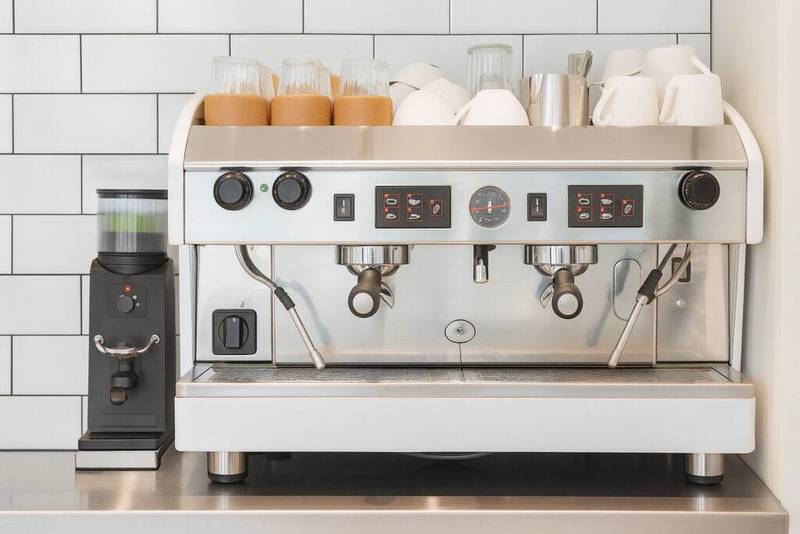Coffee machines have become essential in many households and workplaces, offering the convenience of brewing a fresh cup of coffee whenever you desire. But, as with any electrical appliance, there’s always a concern about energy consumption — and even routine habits, if not managed properly, can sometimes make you sick due to poor maintenance.
Do coffee machines use a lot of electricity?
Understanding your coffee machine’s energy usage is essential not just for managing your electricity bill but also for making eco-friendly choices.
As an affiliate site, we are associated with the amazon. We might receive a commission when you use links or recommendations on our website to make qualified purchases. The cost you pay for the goods or services is unaffected by this.
Table of Contents
Introduction to Coffee Machine Electricity Usage

When we consider the cost of our morning cup of coffee, we often consider the price of the beans, filters, and perhaps even the water. However, we seldom consider the electricity required to run our coffee machines.
With the growing emphasis on energy efficiency and sustainability, it’s vital to understand how much electricity your coffee machine consumes and what factors contribute to its overall energy use.
Types of Coffee Machines and Their Energy Consumption

Different types of coffee machines have different energy consumption rates. Understanding these differences can help you make an informed decision when purchasing a coffee machine that suits your needs while also being mindful of electricity use.
1. Drip Coffee Makers
Drip coffee makers are among the most common coffee machines found in homes and offices. These machines work by heating water and slowly dripping it over coffee grounds.
The energy consumption of drip coffee makers is relatively moderate. A typical drip coffee maker uses between 750 and 1200 watts of electricity. The actual usage depends on the duration it takes to brew the coffee and whether the machine has a hot plate to keep the coffee warm, which can consume additional power.
2. Single-Serve Pod Coffee Makers
Single-serve pod coffee makers like Keurig or Nespresso have gained popularity due to their convenience and quick brewing time. These machines typically use between 900 to 1500 watts of power.
The energy consumption primarily depends on the machine’s heating element, rapidly heating water to the required temperature. While these machines may have a higher wattage, their brewing cycle is often shorter, which can offset some electricity usage.
3. Espresso Machines
Espresso machines are known for producing rich, concentrated coffee, often favored by coffee enthusiasts. These machines can vary significantly in energy consumption, ranging from 1000 to 1500 watts.
Manual and semi-automatic espresso machines use less electricity as they rely on user input for specific functions. In contrast, fully automatic machines may use more electricity due to additional features such as built-in grinders, milk frothers, and automated brewing cycles.
4. French Press and Manual Brewing Methods
French presses and other manual brewing methods, such as pour-over or AeroPress, do not require electricity. However, it’s essential to consider the energy used to heat the water.
If you’re using an electric kettle, the energy consumption would depend on its wattage, which typically ranges from 1200 to 1500 watts. Although manual brewing methods are considered more energy-efficient, the overall energy usage still depends on the equipment used to heat the water.
Factors Affecting Electricity Usage in Coffee Machines

Several factors can affect the electricity consumption of your coffee machine. Understanding these factors can help optimize your usage and reduce energy costs.
1. Brewing Time
The brewing time of a coffee machine significantly impacts its electricity consumption. Machines that take longer to brew coffee will naturally use more electricity. For instance, drip coffee makers that keep coffee warm for extended periods can increase energy usage. Opting for a machine with a thermal carafe instead of a hot plate can reduce energy consumption.
2. Machine Efficiency
The efficiency of a coffee machine also plays a role in its energy usage. High-efficiency machines are designed to use less electricity while still performing effectively. These machines often have features like programmable timers, energy-saving modes, and automatic shut-off functions that help minimize electricity usage.
3. Standby Power Consumption
Many modern coffee machines have standby modes that consume a small amount of electricity even when the machine is not actively brewing. This standby power consumption, often called “phantom load,” can increase over time.
To minimize this, consider unplugging your coffee machine when it’s not in use, or look for Energy Star-certified models designed to reduce standby power consumption.
4. Heating Element and Water Temperature
The type of heating element used in a coffee machine and the temperature it needs to reach can affect electricity usage. Machines that require high temperatures, such as espresso machines, tend to use more electricity. Additionally, some machines have adjustable temperature settings, allowing you to reduce energy usage by selecting a lower brewing temperature.
Tips for Reducing Coffee Machine Electricity Usage

While coffee machines are a staple in many homes and offices, several ways exist to reduce their electricity usage without sacrificing your daily caffeine fix.
1. Choose the Right Coffee Machine
It is crucial to select a coffee machine that aligns with your consumption habits. A single-serve pod machine may be more energy-efficient if you primarily brew single cups of coffee than a large drip coffee maker. Conversely, a drip coffee maker with a thermal carafe might be more suitable if you brew multiple cups throughout the day.
2. Unplug When Not in Use
As mentioned, many coffee machines consume electricity even when not in use. Unplugging your coffee machine when not needed can help reduce this phantom load and lower your electricity bill.
3. Optimize Brewing Settings
If your coffee machine allows for programmable settings, use them to your advantage. Set the machine to brew coffee only when needed and utilize any energy-saving modes available. Additionally, reducing the brewing temperature slightly can save energy without significantly affecting the taste of your coffee.
4. Regular Maintenance
Keeping your coffee machine in good condition can also impact its energy efficiency. Regularly descaling and cleaning the machine ensures it operates smoothly and efficiently, preventing potential energy waste due to clogs or buildup.
Understanding the Cost of Electricity for Your Coffee Machine

To better understand the cost of using your coffee machine, you can calculate the electricity cost based on the machine’s wattage and the rate your electricity provider charges.
Example Calculation
Suppose you have a drip coffee maker that uses 1000 watts (1 kilowatt) and takes 10 minutes (0.167 hours) to brew coffee. If your electricity rate is $0.13 per kilowatt-hour, the cost to brew one pot of coffee would be:

So, brewing one pot of coffee costs approximately 2.2 cents. While this may seem negligible for a single pot, the cost can increase if you brew multiple pots daily.
Read More Guides
- Can I use Coffee Filter instead of CheeseCoth: Cheesecloth MIA? Don’t Despair, Grab a Coffee Filter!
- Can you use Coffee Filters as Cupcake Liners || A Surprising Hack for Cupcake Baking
- Can Instant Coffee make you gain Weight: The Truth about Instant Coffee: Weight loss Friend or Foe?
- Is Instant Coffee Bad for Weight Loss || Weight Loss Do’s and Don’ts
- Can i use Instant Coffee for Tiramisu: Instant Coffee in Tiramisu: Friend or Foe?
FAQs || Do Coffee machines use a lot of Electricity
How much electricity does a coffee machine use per day?
The daily electricity usage of a coffee machine depends on its type, wattage, and how often it’s used. For example, a drip coffee maker used to brew two pots of coffee a day might use around 0.2 to 0.4 kWh, translating to a few cents per day.
Are single-serve coffee makers more energy-efficient?
Single-serve coffee makers can be more energy-efficient if you only brew one cup at a time. They typically have a shorter brewing cycle, which can offset their higher wattage. However, the overall efficiency depends on your coffee consumption habits.
Does leaving a coffee machine plugged in consume electricity?
Yes, many coffee machines consume a small amount of electricity in standby mode, known as phantom load. It’s best to unplug the machine when not in use to avoid this.
Can adjusting the brewing temperature save electricity?
Yes, lowering the brewing temperature can reduce the energy required to heat the water, saving electricity. However, finding a balance between energy savings and maintaining the desired coffee flavor is essential.
Is it worth investing in an Energy Star-certified coffee machine?
Energy Star-certified coffee machines are designed to be more energy-efficient, often featuring lower standby power consumption and energy-saving settings. Investing in such a machine can help reduce electricity usage and potentially lower energy bills.
Conclusion
Understanding your coffee machine’s electricity usage can help you make informed decisions about its use and contribute to energy conservation.
By choosing the right type of machine, optimizing its settings, and being mindful of its operation, you can enjoy your coffee while minimizing its impact on your electricity bill and the environment. Remember, every small effort counts regarding energy efficiency and sustainability.







